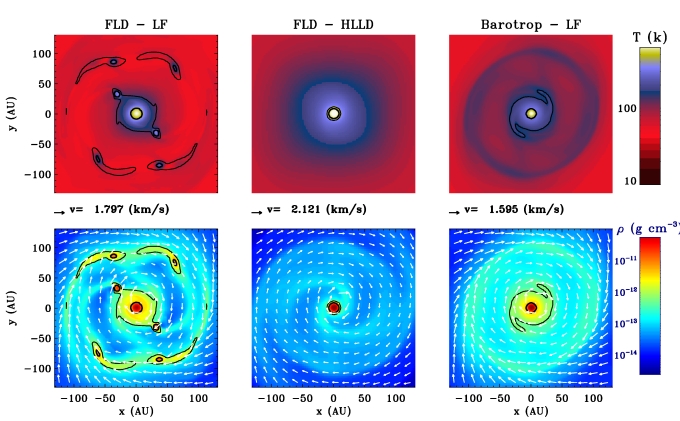| EPoS Contribution |
|
Protostellar collapse: magnetic and radiative feedbacks on small scales collapse and fragmentation
Benoit Commercon Max-Planck-Institut für Astronomie, Heidelberg, Germany | |
| It is established that both radiative transfer and magnetic field have a strong impact on the collapse and the fragmentation of prestellar dense cores. We perform the first Radiation-Magneto-HydroDynamics (RMHD) numerical calculations at a prestellar core scale. I will first briefly discuss the RMHD solver we designed in the RAMSES code. Then I will present original AMR calculations including magnetic field (in the ideal MHD limit) and radiative transfer, within the Flux Limited Diffusion (FLD) approximation, of the collapse of a 1 solar mass dense core. We compare the results with calculations performed with a barotropic EOS. We show that radiative transfer has an important impact on the collapse and the fragmentation, through the cooling or heating of the gas, and is complementary of the magnetic field. A larger field yields a stronger magnetic braking, increasing the accretion rate and thus the effect of the radiative feedback. Even for a strongly magnetized core, where the dynamics of the collapse is dominated by the magnetic field, radiative transfer is crucial to determine the temperature and optical depth distributions, two potentially accessible observational diagnostics. A barotropic EOS cannot account for realistic fragmentation. The diffusivity of the numerical scheme, however, is found to strongly affect the output of the collapse, leading eventually to spurious fragmentation. | |
 | |
| Caption: Magnetized dense core collapse: Density (bottom) and temperature (top) maps in the equatorial plane for three calculations done with: the FLD approximation with the Lax-Friedrich Riemann solver (LF) (left), the FLD with the HLLD Riemann solver (middle) and a barotropic EOS with LF (right). All calculations have been run with the same numerical parameters and the initial mass-to-flux over critical mass-to-flux ratio equals 20. Fragmentation process depends strongly on the numerical scheme. | |
| Collaborators: P. Hennebelle, ENS/OBSPM, France E. Audit, SAp CEA Saclay, France G. Chabrier, CRAL/ENS Lyon, France R. Teyssier, SAP CEA Saclay, France |
Suggested Session:
Cores and Collapse |

